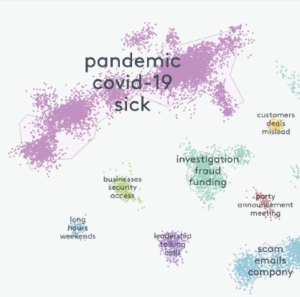Millions Of Documents Transform Into A Manageable Map With New Clustering Tool
Everlaw's latest offering brings clustering into the 21st century.
 Clusters aren’t new to discovery. From the piles of bates-stamped paper littering a conference room table to a number of tools offered by eDiscovery wizards, lawyers always clustered. But it’s been a dirty secret that clustering models were still built on aging tech.
Clusters aren’t new to discovery. From the piles of bates-stamped paper littering a conference room table to a number of tools offered by eDiscovery wizards, lawyers always clustered. But it’s been a dirty secret that clustering models were still built on aging tech.
Everlaw just launched a new clustering tool that launches the practice into the new millennium with algorithms developed in the last few years capable of drawing a striking visual presentation of 25 million documents grouped by AI into easily navigable clouds. Zoom in, find what you want, and then instantly open it up.
Seriously, the interface looks like one of those science videos zooming in on molecules to reveal atoms, followed by protons, followed by quarks, followed by strings, followed by whatever new thing we’ve discovered in a supercollider. As users zoom into the “30,000-foot” page, more clusters appear where you’d logically expect them.

Early Adopters Of Legal AI Gaining Competitive Edge In Marketplace
Everlaw spatial model preserves relationships between documents, even across clusters and zoom levels. It enables a natural, fluid exploration that allows teams to truly discover new evidence as they map out their haystacks and then build compelling storylines.
This infographic puts the differences in stark contrast:

And Everlaw is doing this without any input from the user. The algorithm takes the mountain of documents and identifies conceptual similarities before the user does anything. “With a clean and easy-to-use interface, review teams instantly gain a baseline understanding of the document set without advanced setup or deep technical expertise.” Control-freak lawyers get nervous about turning the first pass over to the machines, but humans can’t grapple with a universe of this magnitude and with a system like this pinpointing specific information and presenting maps for the user to review, it’s actually going to reduce the risk of error.
Sponsored

The Business Case For AI At Your Law Firm


Early Adopters Of Legal AI Gaining Competitive Edge In Marketplace

Is The Future Of Law Distributed? Lessons From The Tech Adoption Curve

Legal AI: 3 Steps Law Firms Should Take Now
Everlaw compares the user interface to navigating Google Earth and it’s an apt comparison.
“Everlaw Clustering allows legal teams to move from a planetary survey of all the evidence in a case all the way down to a blade-of-grass view – a single document – in a unified view,” said Everlaw CEO and Founder AJ Shankar. “Spatial relationships are preserved between documents and clusters, enabling teams to intuitively explore related concepts and discover – in the true sense of the word – new evidence. It is among our biggest achievements to date for its ability to deliver cutting-edge analytics in a consumer friendly design, at a scale relevant to today’s most sophisticated cases.”
“Everlaw Clustering has reinvented the wheel for ediscovery,” said Shankar. Get it? Because the old clustering model created a wheel.
Clustering’s rich review capabilities incorporate overlaying ratings, codes and predictive coding models. For example, in the Review phase of ediscovery, users can utilize existing predictive coding models by overlaying prediction scores onto the visualization to identify clusters that contain many predicted hot documents – pointing them to additional potentially relevant documents in those clusters. Clustering’s overlays can also help conduct quality checks by calling out anomalous ratings and codes, to be assured that documents are reviewed consistently, further removing risks of human error.
And, of course, this is all integrated with the rest of the Everlaw platform, creating an easy one-stop shop for discovery.
Sponsored

Navigating Financial Success by Avoiding Common Pitfalls and Maximizing Firm Performance

Legal AI: 3 Steps Law Firms Should Take Now
 Joe Patrice is a senior editor at Above the Law and co-host of Thinking Like A Lawyer. Feel free to email any tips, questions, or comments. Follow him on Twitter if you’re interested in law, politics, and a healthy dose of college sports news. Joe also serves as a Managing Director at RPN Executive Search.
Joe Patrice is a senior editor at Above the Law and co-host of Thinking Like A Lawyer. Feel free to email any tips, questions, or comments. Follow him on Twitter if you’re interested in law, politics, and a healthy dose of college sports news. Joe also serves as a Managing Director at RPN Executive Search.








